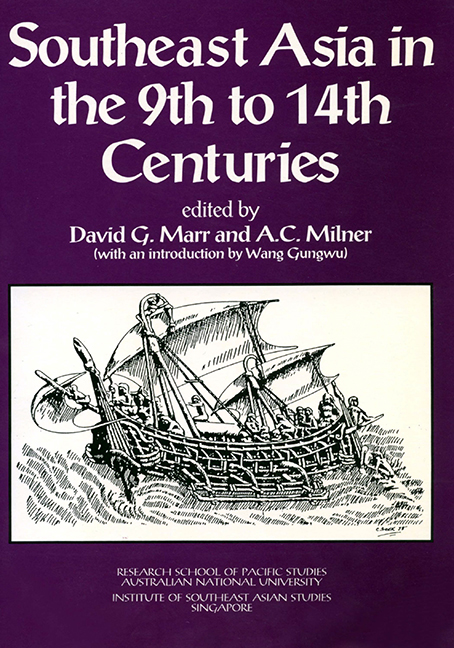Book contents
- Frontmatter
- Contents
- Contributors
- Preface
- Introduction
- 1 The Early and the Imperial Kingdom in Southeast Asian History
- 2 Hydraulic Works and South East Asian Polities
- 3 Some Notes on Relations between Central and Local Government in Ancient Java
- 4 Negara, Mandala, and Despotic State: Images of Early Java
- 5 Some Remarks on Early State Formation in Cambodia
- 6 “Elephants Can Actually Swim”: Contemporary Chinese Views of Late Ly Dai Viet
- 7 Authority and Legitimacy in 11th Century Vietnam
- 8 From Myth to History: Imagined Polities in 14th Century Vietnam
- 9 Shipshape Societies: Boat Symbolism and Political Systems in Insular Southeast Asia
- 10 Changing Perspectives in Island Southeast Asia
- 11 Political and Cultural Continuities at Dvaravati Sites
- 12 The True and the Corbel Arch in Mainland Southeast Asian Monumental Architecture
- 13 Vietnamese Ceramics and Cultural Identity: Evidence from the Ly and Tran Dynasties
- 14 Traditions, Acculturation, Renovation: The Evolutional Pattern of Vietnamese Culture
- 15 Symbolism of Kingship in Arakan
- 16 Buddhism in Champa
- 17 The Ordering of Generations: Change and Continuity in Old Javanese Kinship
- 18 Sources on Economic Activities in Khmer and Cham Lands
- 19 Narrative Bas-Reliefs at Candi Surawana
- 20 Possibilities for a Reading of the 1293-1357 Period in the Vietnamese Annals
- Index
- Miscellaneous Endmatter
3 - Some Notes on Relations between Central and Local Government in Ancient Java
Published online by Cambridge University Press: 21 October 2015
- Frontmatter
- Contents
- Contributors
- Preface
- Introduction
- 1 The Early and the Imperial Kingdom in Southeast Asian History
- 2 Hydraulic Works and South East Asian Polities
- 3 Some Notes on Relations between Central and Local Government in Ancient Java
- 4 Negara, Mandala, and Despotic State: Images of Early Java
- 5 Some Remarks on Early State Formation in Cambodia
- 6 “Elephants Can Actually Swim”: Contemporary Chinese Views of Late Ly Dai Viet
- 7 Authority and Legitimacy in 11th Century Vietnam
- 8 From Myth to History: Imagined Polities in 14th Century Vietnam
- 9 Shipshape Societies: Boat Symbolism and Political Systems in Insular Southeast Asia
- 10 Changing Perspectives in Island Southeast Asia
- 11 Political and Cultural Continuities at Dvaravati Sites
- 12 The True and the Corbel Arch in Mainland Southeast Asian Monumental Architecture
- 13 Vietnamese Ceramics and Cultural Identity: Evidence from the Ly and Tran Dynasties
- 14 Traditions, Acculturation, Renovation: The Evolutional Pattern of Vietnamese Culture
- 15 Symbolism of Kingship in Arakan
- 16 Buddhism in Champa
- 17 The Ordering of Generations: Change and Continuity in Old Javanese Kinship
- 18 Sources on Economic Activities in Khmer and Cham Lands
- 19 Narrative Bas-Reliefs at Candi Surawana
- 20 Possibilities for a Reading of the 1293-1357 Period in the Vietnamese Annals
- Index
- Miscellaneous Endmatter
Summary
In an earlier paper, submitted to the Fourth Indonesian-Dutch Historical Conference at Yogyakarta, July 1983, I tried to analyse the history of the village community in Java during the period from c. A.D. 900 to 1400. Although there still remain numerous problems of detail there is, I think, little doubt concerning the principal rights and duties of the village communities and their members during the period just mentioned. In addition, we have a fair idea of the composition of central government, on which comparatively rich data are available in the Old Javanese texts and inscriptions. As to the relations between these two levels of government, I feel that the general picture is again fairly clear for the fourteenth century, thanks to the Nāgarakĕrtāgama, various other texts and inscriptions. Most of the important data (but excluding the Pararaton, for which we still have to rely on an edition of seventy years ago) have been collected, re-edited and commented on by Pigeaud in his monumental work on Java in the Fourteenth Century. It is true that there still remain numerous problems of detail relating to the precise meaning of a number of Old Javanese terms. Pigeaud may sometimes have been too much inclined to interpret words of uncertain meaning in the light of his admirable knowledge of the political, social and cultural institutions of the Mataram sultanate in the seventeenth and eighteenth century. Yet, it seems clear that Majapahit was governed by a hierarchy of dignitaries and officials with a king at its apex, at least in the central part of the empire corresponding more or less to the present province of Jawa Timur (East Java). Although the villages appear to have possessed a considerable degree of autonomy as far as purely village matters were concerned, we also get the clear impression that the authority of the central government penetrated everywhere and no doubt functioned as a check to the decisions taken by local authorities.
In the above-mentioned paper I also gave some indications as to the manner in which such centralized control may have developed. In the twelfth century, during the period of the kingdom of Kaḍiri, groups of villages were combined into units called by the Sanskrit word wiṣaya, meaning “district”.
- Type
- Chapter
- Information
- Southeast Asia in the 9th to 14th Centuries , pp. 49 - 64Publisher: ISEAS–Yusof Ishak InstitutePrint publication year: 1986

